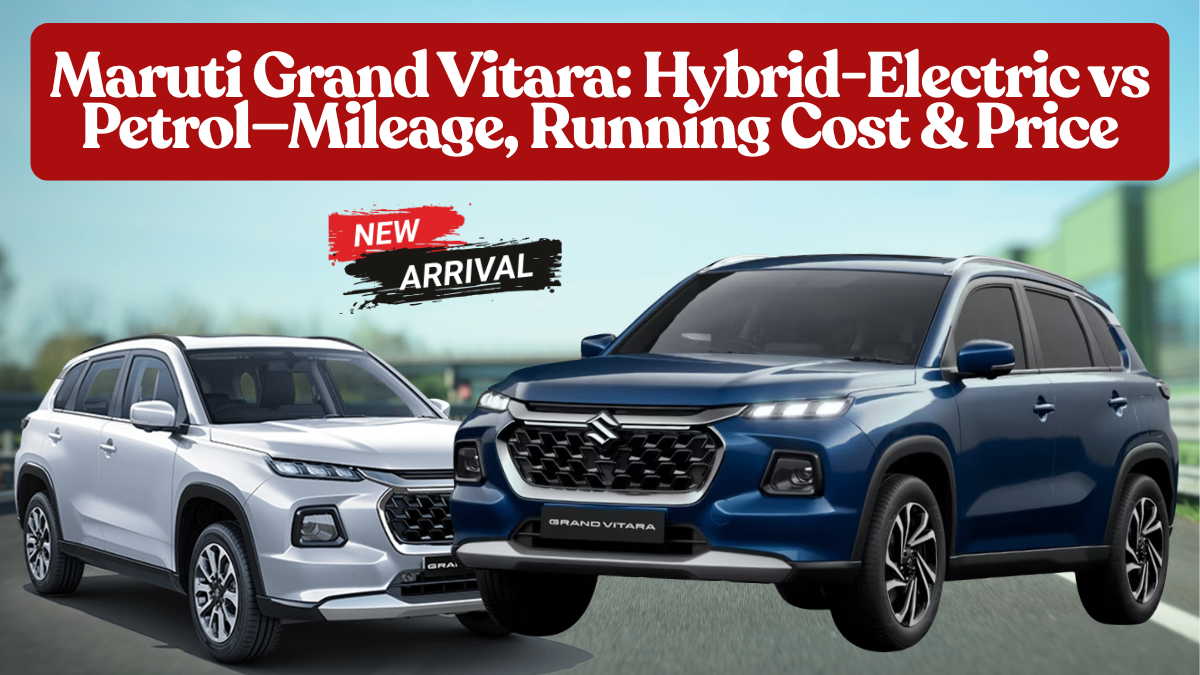The Maruti Grand Vitara has become one of India’s most popular SUVs, offering both petrol and hybrid-electric variants to cater to a wide range of customers. With rising fuel prices and increasing awareness about eco-friendly vehicles, buyers in 2025 are more curious than ever: Is the strong hybrid version really worth it compared to the regular petrol one?
In this detailed comparison, we break down every aspect — mileage, running cost, performance, features, and price — to help you decide which Grand Vitara variant suits your needs best.

Powertrain Overview
The Grand Vitara comes in two major powertrain options:
-
1.5-litre Mild Hybrid Petrol (Smart Hybrid)
-
1.5-litre Strong Hybrid (Intelligent Electric Hybrid)
Let’s understand how these two differ.
The petrol variant uses Maruti’s tried-and-tested K15C engine paired with either a 5-speed manual or a 6-speed automatic gearbox. It delivers around 103 PS and 137 Nm of torque and includes a small lithium-ion battery to assist with idle start-stop and torque boost.
The strong hybrid variant, jointly developed with Toyota, combines a 1.5-litre Atkinson cycle petrol engine (92 PS, 122 Nm) with an electric motor producing 80 PS and 141 Nm. Together, the system generates a combined 115 PS, paired with an e-CVT automatic transmission.
The hybrid model can run purely on electric power for short distances, automatically switching between electric, hybrid, and petrol modes depending on speed and load.
Mileage Comparison
Mileage is where the strong hybrid truly shines.
| Variant | Fuel Type | Transmission | Claimed Mileage (ARAI) | Real-World Mileage |
|---|---|---|---|---|
| Grand Vitara Mild Hybrid | Petrol | Manual | 21.1 km/l | 17–18 km/l |
| Grand Vitara Mild Hybrid | Petrol | Automatic | 20.6 km/l | 16–17 km/l |
| Grand Vitara Strong Hybrid | Hybrid (Petrol + Electric) | e-CVT | 27.97 km/l | 23–25 km/l |
In city driving, the hybrid system gives a significant boost since the car frequently switches to EV mode during low-speed traffic, saving fuel. On highways, the difference narrows slightly but remains noticeable.
Over a typical 1,000 km of mixed driving, the hybrid version consumes nearly 35% less fuel than the petrol variant, which translates into meaningful savings in the long term.
Running Cost Comparison
Fuel efficiency directly impacts running costs. Let’s break down the monthly and yearly cost estimates based on fuel prices in October 2025.
Assumptions:
-
Petrol price: ₹105/litre (average across metros)
-
Mileage: 25 km/l (Hybrid) vs 18 km/l (Petrol)
-
Average monthly usage: 1,000 km
| Variant | Fuel Type | Monthly Fuel Cost | Annual Fuel Cost |
|---|---|---|---|
| Mild Hybrid Petrol | Petrol | ₹5,833 | ₹70,000 |
| Strong Hybrid | Petrol + Electric | ₹4,200 | ₹50,400 |
That’s a difference of ₹19,600 per year, meaning the hybrid starts paying back its higher initial cost in 4–5 years, depending on usage.
Performance and Drive Feel
Both variants cater to different driving preferences.
The petrol mild hybrid feels traditional — simple, linear, and predictable. It’s refined at low speeds but lacks punch during overtakes or when loaded with passengers. The 6-speed automatic offers convenience, but downshifts can feel slightly delayed under heavy throttle.
The strong hybrid, on the other hand, feels far more sophisticated. Thanks to the instant torque from the electric motor, it accelerates smoothly and silently in traffic. The transition between petrol and electric modes is seamless, and the e-CVT gearbox ensures buttery power delivery.
While not a performance SUV, the hybrid version feels more effortless in city conditions, especially during start-stop traffic, where it remains impressively quiet and efficient.
Maintenance and Ownership Costs
Maintenance is another area where both models differ slightly.
The mild hybrid has lower upfront servicing costs and simpler mechanical components. It follows Maruti’s standard service intervals of 10,000 km or 1 year, and the annual maintenance expense averages around ₹6,000–₹7,000.
The strong hybrid has more complex electrical components but is built for long-term durability. Battery packs are covered under warranty (usually 8 years or 1.6 lakh km) and rarely need replacement in the first decade. The hybrid requires fewer brake pad changes due to regenerative braking, which saves wear and tear.
Average yearly maintenance for the hybrid is around ₹8,000–₹9,000, slightly higher but offset by lower fuel bills.
Features and Comfort
Feature distribution between both variants is quite similar, with the hybrid getting a few extras to justify its higher price.
Common Features (Both Variants):
-
LED headlamps and DRLs
-
17-inch alloy wheels
-
9-inch SmartPlay Pro+ touchscreen
-
Wireless Android Auto & Apple CarPlay
-
360° camera and hill-hold assist
-
Dual-zone climate control
-
6 airbags and ESP
Additional Features (Hybrid Only):
-
Fully digital instrument cluster
-
EV drive mode selector
-
Ambient lighting
-
Ventilated seats
-
Rear disc brakes
-
Additional sound insulation for cabin quietness
The interior quality is consistent across both versions, but the hybrid cabin feels more premium due to added refinement and silent operation.
Price Comparison (Oct 2025)
As of October 2025, the prices for the Grand Vitara variants (ex-showroom Delhi) are approximately:
| Variant | Transmission | Ex-Showroom Price | On-Road Price |
|---|---|---|---|
| Grand Vitara Sigma (Petrol MT) | Manual | ₹10.99 lakh | ₹12.85 lakh |
| Grand Vitara Zeta (Petrol AT) | Automatic | ₹13.99 lakh | ₹15.90 lakh |
| Grand Vitara Zeta+ (Hybrid e-CVT) | Automatic | ₹17.99 lakh | ₹20.50 lakh |
| Grand Vitara Alpha+ (Hybrid e-CVT) | Automatic | ₹18.75 lakh | ₹21.40 lakh |
The strong hybrid costs about ₹3.5–4 lakh more than the equivalent petrol variant, which is a significant difference but reasonable given the technology and long-term savings.
Which One Should You Buy?
If you primarily drive within the city, face frequent traffic, and plan to own the car for 5+ years, the strong hybrid is the clear winner. Its smooth performance, low fuel cost, and quiet operation make it perfect for urban environments.
However, if you’re a highway commuter or prefer a lower initial investment, the mild hybrid petrol offers a solid balance of performance, reliability, and affordability.
Buyer’s Verdict
The Maruti Grand Vitara Strong Hybrid may cost more upfront, but its fuel efficiency and long-term savings make it a smarter choice for frequent users. The petrol version, however, remains ideal for occasional drivers who value simplicity and lower purchase costs.
Both variants uphold Maruti’s promise of dependability, making the Grand Vitara a strong contender in India’s mid-size SUV market. The hybrid version also strengthens Maruti’s commitment to sustainable mobility without compromising comfort and performance.
FAQs
What is the mileage difference between the Grand Vitara hybrid and petrol versions?
The hybrid offers around 27–28 km/l (ARAI), while the petrol variant delivers around 20–21 km/l, giving the hybrid nearly 35% better fuel efficiency.
Is the Grand Vitara hybrid worth buying?
Yes, if you drive frequently and plan to keep the car long-term, the hybrid’s fuel savings can offset its higher cost within 4–5 years.
What is the battery warranty for the Grand Vitara hybrid?
Maruti offers an 8-year or 1.6 lakh km warranty on the hybrid battery pack.
Which variant is better for highway drives?
The mild hybrid petrol is better for highways, offering steady performance and lower upfront cost.
What is the price difference between hybrid and petrol Grand Vitara variants?
The hybrid costs about ₹3.5–₹4 lakh more than the comparable petrol variant (ex-showroom, Oct 2025).
Click here to know more.
